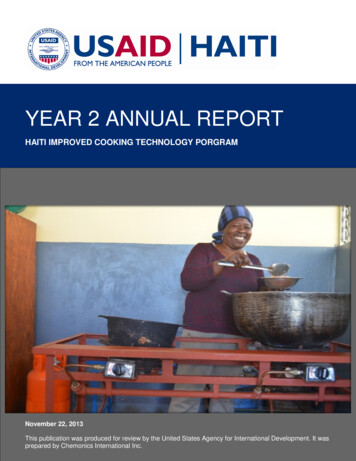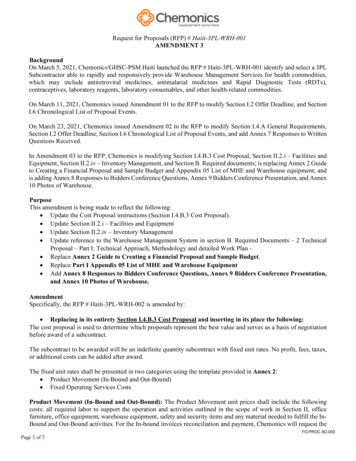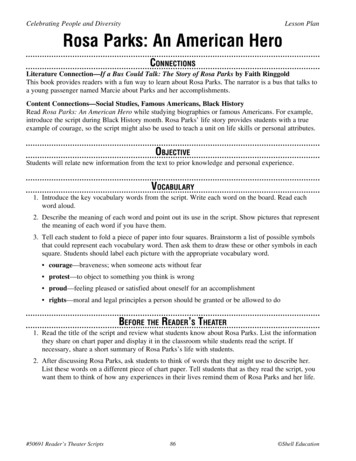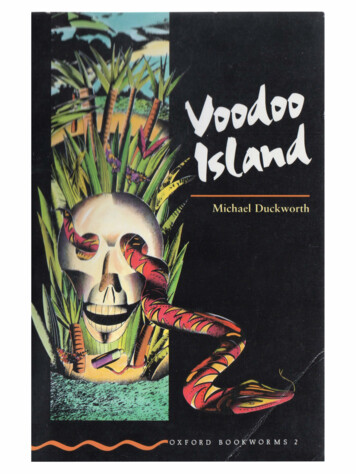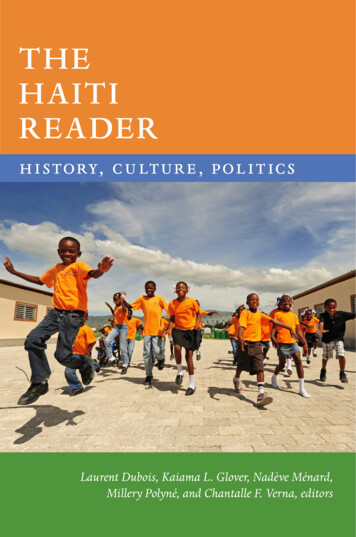
Transcription
THEHAITIREADERH i story, Cu ltur e, Pol i t icsLaurent Dubois, Kaiama L. Glover, Nadève Ménard,Millery Polyné, and Chantalle F. Verna, editors
T H E L AT I N A M ER IC A R E A DER SSeries edited by Robin Kirk and Orin Starn, founded by Valerie MillhollandTHE ARGENTINA READEREdited by Gabriela Nouzeilles and Graciela MontaldoTHE BRAZIL READER, 2ND EDITIONEdited by James N. Green, Victoria Langland, and Lilia Moritz SchwarczTHE BOLIVIA READEREdited by Sinclair Thomson, Seemin Qayum, Mark Goodale,Rossana Barragán, and Xavier AlbóTHE CHILE READEREdited by Elizabeth Quay Hutchison, Thomas Miller Klubock,Nara Milanich, and Peter WinnTHE COLOMBIA READEREdited by Ann Farnsworth-Alvear, Marco Palacios,and Ana María Gómez LópezTHE COSTA RICA READEREdited by Steven Palmer and Iván MolinaTHE CUBA READER, 2ND EDITIONEdited by Aviva Chomsky, Barry Carr, Alfredo Prieto,and Pamela Maria SmorkaloffTHE DOMINICAN REPUBLIC READEREdited by Paul Roorda, Lauren Derby, and Raymundo GonzálezTHE ECUADOR READEREdited by Carlos de la Torre and Steve StrifflerTHE GUATEMALA READEREdited by Greg Grandin, Deborah T. Levenson, and Elizabeth OglesbyTHE LIMA READEREdited by Carlos Aguirre and Charles F. WalkerTHE MEXICO READEREdited by Gilbert M. Joseph and Timothy J. HendersonTHE PARAGUAY READEREdited by Peter Lambert and Andrew NicksonTHE PERU READER, 2ND EDITIONEdited by Orin Starn, Iván Degregori, and Robin KirkTHE RIO DE JANEIRO READEREdited by Daryle Williams, Amy Chazkel, and Paulo Knauss
T H E WOR L D R E A DER SSeries edited by Robin Kirk and Orin Starn, founded by Valerie MillhollandTHE ALASKA NATIVE READEREdited by Maria Shaa Tláa WilliamsTHE BANGLADESH READEREdited by Meghna Guhathakurta and Willem van SchendelTHE CZECH READEREdited by Jan Bažant, Nina Bažantová, and Frances StarnTHE GHANA READEREdited by Kwasi Konadu and Clifford CampbellTHE INDONESIA READEREdited by Tineke Hellwig and Eric TagliacozzoTHE RUSSIA READEREdited by Adele Barker and Bruce GrantTHE SOUTH AFRICA READEREdited by Clifton Crais and Thomas V. McClendonTHE SRI LANKA READEREdited by John Clifford Holt
The Haiti Reader
THEHAITIR EA DERH istory , C ulture , P oliticsLaurent Dubois, Kaiama L. Glover, Nadève Ménard,Millery Polyné, and Chantalle F. Verna, editorsDuke U niversity P ressDurham and London2020
2020 Duke University PressAll rights reservedPrinted in the United States of America on acid-free paper Typeset in Monotype Dante by BW&A Books, Inc.The Cataloging-in-Publication Data is available at the Library of Congress.isbn 9781478007609 (ebook)isbn 9781478005162 (hardcover)isbn 9781478006770 (paperback)Cover art: Haitian schoolchildren. Anthony Asael/Art in All of Us/Corbis News. Courtesy of Getty Images.
For our children,especially the youngest of the bunch,Serenity Macaya Verna
ContentsAcknowledgmentsIntroduction 1xiiiI Foundations 7An Account of the Antiquities of the Indians, Ramón Pané 8Sou lanmè, Anonymous 13Account of a Conspiracy Organized by the Negroes, 1758, Anonymous 16The Infamous Rosalie, Évelyne Trouillot 19The Declaration of Independence, Jean-Jacques Dessalines 23Haitian Hymn 27Writings, Jean-Jacques Dessalines 29A Woman’s Quest for Freedom in a Land of Re-enslavement,Marie Melie 31An Exchange of Letters, Alexandre Pétion and Simón Bolívar 33The Code Henry, King Henry Christophe 36Haitian Heraldry, Kingdom of Henry Christophe 39Henry Christophe and the English Abolitionists, King Henry Christophe 41The Colonial System Unveiled, Baron de Vastey 45Hymn to Liberty, Antoine Dupré 51The King’s Hunting Party, Juste Chanlatte 53Voyage to the North of Haiti, Hérard Dumesle 58On the Origins of the Counter-plantation System, Jean Casimir 61IIThe Second Generation 67The Indemnity: French Royal Ordinance of 1825,King Charles X of France 68Hymn to Independence, Jean-Baptiste Romane 70Boyer’s Rural Code, Jean-Pierre Boyer 72Le lambi, Ignace Nau 75An Experimental Farm, Victor Schoelcher 81The 1842 Earthquake, Démesvar Delorme 83
Acaau and the Piquet Rebellion of 1843, Gustave d’Alaux 90The Separation of Haiti and the Dominican Republic, Thomas MadiouPresident Geffrard Protests the Spanish Annexation ofthe Dominican Republic, Fabre Geffrard 100Stella, the First Haitian Novel, Émeric Bergeaud 105Haiti and Its Visitors and “Le vieux piquet,” Louis Joseph Janvier 109Atlas critique d’Haïti, Georges Anglade 122IIIThe Birth of Modern-Day Haiti94127Nineteenth-Century Haiti by the Numbers, Louis Gentil Tippenhauer 129Family Portraits 131My Panama Hat Fell Off, Anonymous 132God, Work, and Liberty!, Oswald Durand 133The National Anthem, “La Dessalinienne,” Justin Lhérissonand Nicolas Geffrard 136Trial about the Consolidation of Debt, Various Authors 138The Execution of the Coicou Brothers, Nord Alexis and Anténor Firmin 144The Luders Affair, Solon Ménos 147Anti-Syrian Legislation, Haitian Legislature 150Choucoune, Oswald Durand 153Bouqui’s Bath, Suzanne Comhaire-Sylvain 156Zoune at Her Godmother’s, Justin Lhérisson 159The Haytian Question, Hannibal Price 163African Americans Defend Haiti, Ebenezer Don Carlos Bassett 167On the Caribbean Confederation, Anténor Firmin 169IVOccupied Haiti (1915–1934)1771915 Treaty between the United States and Haiti, Robert Beale Davis Jr.and Louis Borno 180The Patriotic Union of Haiti Protests the U.S. Occupation,Union Patriotique d’Haiti 186Memories of Corvée Labor and the Caco Revolt, Roger Gaillard 194The Crucifixion of Charlemagne Péralte, Philomé Obin 198“My Dear Charlemagne,” Widow Massena Péralte 200La vocation de l’élite, Jean Price-Mars 202Dix années de lutte pour la liberté, Georges Sylvain 211Les simulacres, Fernand Hibbert 225La Revue Indigène: The Project, Normil Sylvain 227La Revue Indigène: The Poetry, Various Authors 233La blanche négresse, Cléante Valcin 239xContents
Souvenir d’Haïti, Othello Bayard 243Veneer of Modernization, Suzy CastorV245Second Independence 251Vincent and Trujillo 255Proud Haiti, Edouard A. Tardieu 256Color Prejudice, Jacques Roumain 259Migration to Cuba, Maurice Casséus and Jacques Roumain 262Anti-superstition Laws, President Sténio Vincent 265An Oral History of a Massacre, Isil Nicolas Cour 267Massacre River, René Philoctète 276On the 1937 Massacre, Esther Dartigue 279Official Communiqué on “Incidents” in the Dominican Republic,Governments of Haiti and the Dominican Republic 282Vyewo, Jean-Claude Martineau 284Nedjé, Roussan Camille 286Dyakout, Félix Morisseau-Leroy 289Estimé Plays Slot Machine in Casino, Gordon Parks 294On The Voice of Women, Madeleine Sylvain Bouchereau 296On Women’s Emancipation, Marie-Thérèse Colimon-Hall 298On the 1946 Revolution, Matthew J. Smith 300VI The Duvalier Years307O My Country, Anthony Phelps 309General Sun, My Brother, Jacques Stephen Alexis 324Flicker of an Eyelid, Jacques Stephen Alexis 327The Sad End of Jacques Stephen Alexis, Edouard Duval-Carrié 329The Trade Union Movement, Daniel Fignolé and Jacques Brutus 330Speech by the “Leader of the Revolution,” François Duvalier 336The Haitian Fighter, Le Combattant Haïtien 340Atibon-Legba, René Depestre 342The Festival of the Greasy Pole, René Depestre 346Dance on the Volcano, Marie Chauvet 349Interview of Jean-Claude Duvalier: Duvalier’s “Liberal” Agenda,Jon-Blaise Alima 354On the Saut-d’Eau Pilgrimage, Jean Dominique 357Dreams of Exile and Novelistic Intent, Jean-Claude Fignolé 365Dezafi, Frankétienne 368And the Good Lord Laughs, Edris Saint-Amand 373Letter to the Haitian Refugee Project, Various ImprisonedHaitian Refugee Women 378Contentsxi
Immigration, Tanbou Libète 384Gender and Politics in Contemporary Haiti, Carolle CharlesVII Overthrow and Aftermath of Duvalier386389Jean-Claude Duvalier with a Monkey’s Tail, 1986, Pablo Butcher 392Four Poems, Georges Castera 394Liberation Theology, Conférence Épiscopale d’Haïti 397On the Movement against Duvalier, Jean Dominique 403Interview with a Young Market Woman, Magalie St. Louisand Nadine Andre 407Nou vle, Ansy Dérose 413The Constitution of 1987, Government of Haiti 416Rara Songs of Political Protest, Various Groups 421Haitians March against an FDA Ban on Haitian Blood Donations,Richard Elkins 424The Peasants’ Movement, Tèt Kole 426Aristide and the Popular Movement, Jean-Bertrand Aristide 430My Heart Does Not Leap, Boukman Eksperyans 437On Theology and Politics, Jean-Bertrand Aristide 440Street of Lost Footsteps, Lyonel Trouillot 445VIII Haiti in the New Millennium449The Agronomist, Kettly Mars 452Poverty Does Not Come from the Sky, AlterPresse 456Pòtoprens, BIC 459Political Music from Bel Air, Rara M No Limit, Bèlè Masif,and Blaze One 462Strange Story, Bélo 468Faults, Yanick Lahens 470Everything Is Moving around Me, Dany Laferrière 476We Are Wozo, Edwidge Danticat 480Haïti pap peri, Jerry Rosembert Moïse 483The Cholera Outbreak, Roberson Alphonse 487On the Politics of Haitian Creole, Various Authors 490Stayle, Brothers Posse 498To Reestablish Haiti?, Lemète Zéphyr and Pierre Buteau 502Suggestions for Further Reading and Viewing 513Acknowledgment of Copyrights and Sources 519Index 527xiiContents
AcknowledgmentsThe Haiti Reader has been a long, rich, and deeply collective endeavor. Whenwe have explained the project to those we have reached out to for help, we’veencountered great generosity and enthusiasm for the bigger project of sharing these many Haitian histories, voices, and perspectives.Our first thanks go to Duke University Press, who came to us with theidea and have guided and collaborated with us with patience and wisdomthroughout. Navigating the rights issues for both text and images across multiple countries has been exceedingly complex, and we would have been quiteliterally lost without the many at the press who helped us in this process. Ourmarvelous editors—Valerie Millholland, who first invited us to the project,and Gisela Fosado, who has accompanied us for the long journey—have beenconstant voices of guidance and reassurance. Lydia Rose Rappoport-Hankinswas a steadfast guide for us at the press, and Emily Chilton provided a pivotal, organizing perspective at a key moment. A series of graduate studentsfrom Duke who worked as interns on the project over its many years haveoffered invaluable support: Lorien Olive, Casey Stegman, Anna Tybinko, Nehanda Loiseau, Ayanna Legros, and Renee Ragin. And Jenny Tan helped usprofoundly in shaping the visual landscape of the book. In the early yearsof the project the Haiti Laboratory of the Franklin Humanities Laboratorywas itself a laboratory for the reader, where we hosted meetings and also depended on the work of research assistants Julia Gaffield and Claire A. Paytonin beginning to pull together our entries.We are deeply indebted to the contributing editors who responded to ourrequests to join us in the project and provided introductions and in many casestranslations for particular excerpts: Yveline Alexis, Alessandra B enedictyKokken, Christopher Bongie, Victor Bulmer-Thomas, Brandon Byrd, LesleyS. Curtis, Marlene Daut, Colin Dayan, Anne Eller, Julia Gaffield, JohnhenryGonzalez, Allen Kim, Wynnie Lamour, Carl Lindskoog, Andrew Maginn,Christen Mucher, Graham Nessler, Rose Réjouis, Terry Rey, Grace Saunders,Matthew J. Smith, Richard Turits, and Laura Wagner. They are all importantscholars of Haiti in their own work, and they took the time to share theirexpertise with us, making the book infinitely broader and better. They arerecognized within the body of the work, which identifies the contributingeditor for a given excerpt when there was one. But we are grateful to themxiii
too as a collective that embodies the best of what scholarly generosity andcollaboration are about.The field of Haitian Studies is a lovely home for us as editors, and we havefound it to be a nourishing and generous space to work on this project, whichwe hope will be a valuable contribution to our extended network. We have received invaluable advice and support from many scholars, family, and friends,including Michel Acacia, Alice Backer, Patrick Bellegarde-Smith, Pierre Buteau, Laurence Camille, Jean Casimir, Stephanie Chancy, Michael Dash, AlexDupuy, Robert Fatton Jr., Gerdy Gabriel, Dimmy Herard, Mireille JérÔme,Sophonie Joseph, Chelsey Kivland, Antoine Lévy, Lindja Levy, Bertin M.Louis, Ana Marie Greenidge Ménard, Guy-Gérald Ménard, Allen Morrison,Jerry Philogène, Kate Ramsey, Carline Rémy, Enrique Silva, Évelyne Trouillot, and Lyonel Trouillot. We are also grateful for the suggestions of twoanonymous reviewers who read our proposal and whose comments helpedshape the final work.We depended on some of the precious libraries and collections that maintain Haitian Studies, who provided us guidance and support throughout theprocess. We are especially grateful to the Duke University Libraries, andparticularly the Rubenstein Special Collections Library; the Library of theÉcole Normale Supérieure in Haiti; the holders of the Sylvain Collection; andFrantz Voltaire of cidihca . Voltaire was particularly generous in allowingus to use materials from his photographic collection, many of which illustrate the book. More broadly, we thank all the rights-holders who grantedus permission to reproduce works here, and the authors, songwriters, andphotographers who gave us permission to include their work. Special thanksto Lena Jackson, for working with us to include the works of Jerry Moïse; andto photographers Phyllis Galembo, Carl Juste, Noelle Flores Theard, and theFotoKonbit collective. We thank Elizabeth McAlister for sharing her expertise and a photograph of a rara band.A number of dear friends and family gave of their time to read the volume,encourage us, and provide us with the space to write, and time to think andtravel. Thank you to Judy C. Polyné for your attention to detail and your accounting skills, and to all our families and colleague-friends for their supportall the way through this journey.xivAcknowledgments
IntroductionAt times it can seem as if Haiti is on everyone’s mind—at least for a newscycle or two. Yet despite periods of intensive interest in Haiti, there is, overall, a surprising lack of knowledge about the specifics of the country’s historyand culture in the United States. And the way Haiti is viewed by natives andforeigners runs a wide gamut: for Martinican poet Aimé Césaire, Haiti is theplace where “Négritude rose up for the first time and stated that it believed inits humanity,” but for many in the United States the country is characterizedby the endlessly repeated taglines and memes about its extreme poverty andperceived inhabitability or seen primarily as a site of political turmoil andbackward cultural practices. For many Haitians, meanwhile, Haiti is a placefrom which to escape by any means, even at the risk of death. For many others, Haiti is the ultimate “manman cheri,” the place of true home, the one towhich they will always return.Haiti’s presence in both the Caribbean and global imaginary has long beencolossal. Whether celebrated for its revolution and victory over NapoleonBonaparte’s army or disparaged for its poverty and political instability, Haitiis a highly symbolic nation. Yet few beyond Haitians and Haitianists, specialists of the country, venture beyond the symbols. One way to understand thelimited knowledge about Haiti is as a consequence of isolating linguistic barriers. That is, while the United States is currently the most powerful externalforce shaping Haiti’s political and economic reality, the country’s literary andintellectual production since independence in 1804—along with its juridicaland political life—is predominantly francophone. Yet French is in fact a minority language in Haiti, as the majority of the population speaks exclusivelyHaitian Creole—a language accessible to relatively few non-Haitians. As a result, even while select U.S. Americans are deeply connected to and interestedin Haiti, few have more than a cursory knowledge of the country’s historicaland cultural realities. Those who seek to learn about Haiti find themselvesalmost entirely reliant on the writings of non-Haitians or Haitian writers residing in diaspora. And while a sizable portion of writing about the countryby non-Haitians is certainly well informed and based on a long engagementwith Haiti, an overwhelmingly negative narrative has also been constructedaround the island nation. Indeed, few places have been on the receiving endof as much hostility, distortion, and fantasy on the part of outsiders.1
CUBAPort de PaixCap HaïtienMôle St. NicolasGonaivesSaint MarcHAITILa GonâveJérémiePort-au-PrinceJacmelLes Cayes50 kmDOMINICANREPUBLICÎle-à-Vache30 miMap of HaitiUnited StatesAT L A N T I C O C E A N500 km300 miG U L F O F M E X I COThe N SEAEl SalvadorNicaraguaColombiaMap of CaribbeanVenezuela
The Haiti Reader seeks primarily to introduce a broad audience of anglophone readers to Haiti via the cultural productions of Haitians themselves.Having selected representative works from the nation’s scholarly, literary,religious, visual, musical, and political culture, we hope to make plain theextent to which Haitians have long understood themselves as part of an extra-insular, progressive human community. We have sought to identify andtranslate key texts—poems, novels, political tracts, essays, legislation, songs,testimonies, folktales—that illuminate Haiti’s history and culture. We haveprioritized the presentation of material from Haitian writers and thinkers,much of it translated into English for the first time here, and have includedonly a very few writings by foreign observers, which are generally easier toaccess. Our process of selection has also been guided by a desire to offer akind of counternarrative, highlighting some lesser-known aspects of Haitianlife and culture. But overall we aim to offer as full a representation as possibleof well-known as well as lesser-known periods in Haiti’s past. The volumeopens and closes with two transformative moments in Haitian history: thecreation of the Haitian state in 1804 and the 2010 earthquake. In addition, weexplore both widely known episodes in Haiti’s history, such as the U.S. military occupation and Duvalier dictatorship, and such often-overlooked periods as the “long” nineteenth century and the decades immediately followingHaiti’s “second independence” (i.e., the end of the U.S. occupation) in 1934.Given Haiti’s far-reaching and complex entanglements with North America, Europe, other parts of the Caribbean, Latin America, and Africa, thisreader is necessarily national and transnational in scope. As such, it will standas a challenge to the way Haitians have, despite their determining role inNew World political history and geography, found themselves isolated andunwelcomed outside (and often even inside) their own island—bounded andunwanted, faced with countless obstacles to inhabiting the wider world. Ourcollection looks closely at the extent to which regional aesthetic canons ghettoize Haiti’s literary production and exacerbate the nation’s sociopoliticalisolation. Less widely circulated than works from other parts of the (francophone) Americas, Haitian writing has indeed had far less access to the mostfundamental prerequisite for circulation: translation. The Haiti Reader takessteps toward addressing that exclusion by showcasing excerpts from a widerange of literary works by Haitian writers, many of them relatively unknownto anglophone audiences.Even though Haitian thinkers have had vital engagement with issues ofrace and racism, nationalism, cultural formation, colonialism, postcolonialism, and political theory, Haitian thought remains largely on the marginsof broader debates and canons. To take but one example among many, thepioneering work of Anténor Firmin—who in the late nineteenth century attacked the scientific racism of reigning anthropology in a work that presagedthe later approach of Franz Boas—was not translated into English until 2002Introduction3
and remains largely excluded from understandings of the history of anthropological thought. In effect, for the past two centuries, Haitian intellectualslike Firmin have been in dialogue with theoretical currents in Europe andthe Americas and have sought to both confirm and challenge broader interpretive frameworks by drawing on their country’s historical experience. Ourbook pays particular attention to the work of such intellectuals, providingthose who read what follows with a clearer sense of Haiti’s nation-buildingefforts and engagement with the world from the nineteenth century to thepresent day.Our strategy in composing The Haiti Reader is premised on an acknowledgment of Haiti’s marginalization and the consequent importance of situatingthe country and its cultural contributions squarely in the heart of the Americas. Recent scholarship on Haiti reveals its significant imbrication in cultural,ideological, and radical social movements in the Western Hemisphere andbeyond—including abolitionism, Pan-Americanism, Pan-Africanism, internationalism, Indigenism, Négritude, and decolonization. The Haitian Constitution of 1816, for example, granted citizenship to all Africans and Indiansseeking residence in Haiti. This proved to be a powerful legal decree giventhe intensification of slavery in the Caribbean and the United States, and thepotential of enslaved peoples (sailors, maids, cooks, etc.) to step onto freeHaitian soil. As such, the Haitian Constitution had significant implicationswith respect to broader New World discourses on property rights, citizenship, sovereignty, and freedom.At the same time, The Haiti Reader explicitly addresses and reflects thevarious borders within the country. Haiti’s rather ambivalent status as a“francophone” nation, for example, raises important questions concerningwho “gets to” write—and so to represent—this country and its inhabitants:from the working- and middle-class Haitian diasporans who actively impartremittances and humanitarian aid through hometown associations, to theprivileged border-crossing members of the intellectual and merchant eliteclass and the individuals and communities that are the subjects and consumers of their works and products. Our goal throughout the Reader is thereforeto place in dialogue—and at times in tension—texts from different placeswithin Haitian society, drawing on aspects of vernacular culture, particularly popular and religious music, to reflect the multiplicity and diversity ofperspectives within the country itself.The Haiti Reader is composed of eight chronological parts. Each sectionbegins with a contextualizing introduction. We then present three kinds ofdocuments in each section: visual materials; contemporary texts, includinglaws and political documents, essays, poems, and literary texts; and excerptsfrom scholarly works contextualizing the particular period and presentingbroader approaches to thinking about Haitian history and culture. Unlessotherwise noted, all ellipses are ours, added to indicate omitted material.4Introduction
Our selections are not—could not be—exhaustive, and we have mademany difficult choices while deciding what to include. Certain of these omissions were a matter of logistics: in several instances where we wished tofeature certain authors or texts, the difficulty or expense of obtaining therights to reproduce them here proved prohibitive. We have also had to beselective in fixing our temporal parameters. The Reader is almost exclusivelyfocused on postindependence Haiti, offering little material on colonial SaintDomingue or the Haitian Revolution. Readers interested in material on theHaitian Revolution can refer to Laurent Dubois and John Garrigus, Slave Revolution in the Caribbean, 1787–1804: A History in Documents (2006). In addition,there are fields of interest whose surface we have barely scratched. One ofthe more significant is queer Haitian Studies, most recently and compellinglyadvanced in the work of scholars like Dasha A. Chapman, Erin L. DurbanAlbrecht, and Mario LaMothe in their pioneering issue of Women and Performance: a journal of feminist theory, “Nou Mache Ansanm (We Walk Together):Queer Haitian Performance and Affiliation.” Indeed, there could be manyother versions of a reader based on Haiti and its history, and we hope futurescholars will continue the task of translating and publishing a broader arrayof works by Haitian writers and thinkers. Our hope for this text is that it willhelp readers discover certain topics and writers so that they can then delveinto them more deeply. We offer it as an invitation into the vast corpus—anextensive archipelago—of Haitian thought, whose marvels and diversity wehave sought to illuminate in the pages that follow.We would like to add a few words on language here. We have focusedparticularly on making sure that the voices of Haitian writers who are notwell known to anglophone readers can be made accessible, and a majority ofthe featured texts are translated here for the first time. We have sought tooffer translations that allow anglophone readers to enjoy these texts whilemaintaining the style and energy of the original—including, in some cases,original terms in Creole and French. This being said, the fact that The HaitiReader is presented in English somewhat obscures Haitian linguistic reality.Although Haitian Creole was only granted official language status with the1987 Constitution, both French and Haitian Creole have been integral partsof the country’s linguistic fabric dating from the colonial period, even if historically they have followed different paths. While French was brought tothe island by European colonizers and imposed as the language of authority,Haitian Creole was forged by the merging of various languages and peopleswithin the new society. Both languages underwent many internal transformations as well as shifts in their relationship to each other over the centuries. Today, in addition to the two official languages, English and Spanish arealso widely spoken within certain segments of Haitian society, and in variousregions of the country. It is impossible for us to render such linguistic complexity with translations into one target language. Nonetheless, we want toIntroduction5
remind our readers that the majority of texts presented here were translatedeither from Haitian Creole or from French. Several creative texts make use ofboth languages. Traditional distinctions that view Creole as an oral languagemainly used by the poor and disenfranchised, and French as a written language mainly used in formal situations or by the elite, require nuance todaymore than ever. We have done our best to communicate this linguistic complexity through our introductions and translations, and we urge those whoare able to read the texts in their original languages to seek out the originalsand do so where possible as a next step to a greater understanding of Haiti’slanguages and culture.In addition to the five main editors, we also worked with contributingeditors who generously offered us selections and translations from their ownwork. In this sense The Haiti Reader is the result of a true konbit (cooperative,communal labor). It channels the much larger and energetic field of Haitianstudies, and we hope, contributes to ever-expanding research and discussionabout Haiti and its many connections to the human experience worldwide.6Introduction
Edited by Aviva Chomsky, Barry Carr, Alfredo Prieto, and Pamela Maria Smorkaloff THE DOMINICAN REPUBLIC READER Edited by Paul Roorda, Lauren Derby, and Raymundo González THE ECUADOR READER Edited by Carlos de la Torre and Steve Striffler THE GUATEMALA READER Edi
